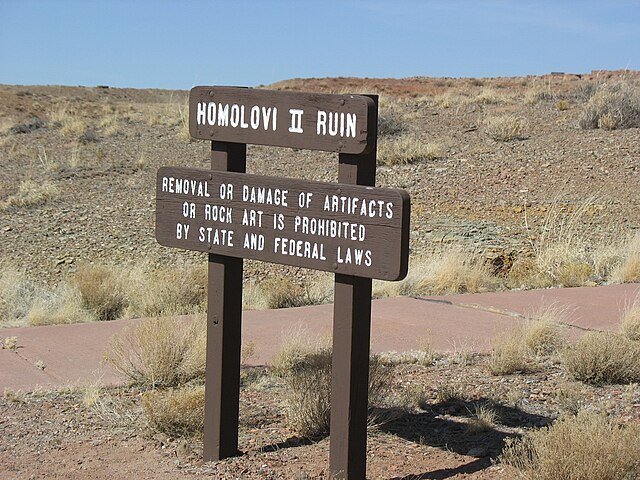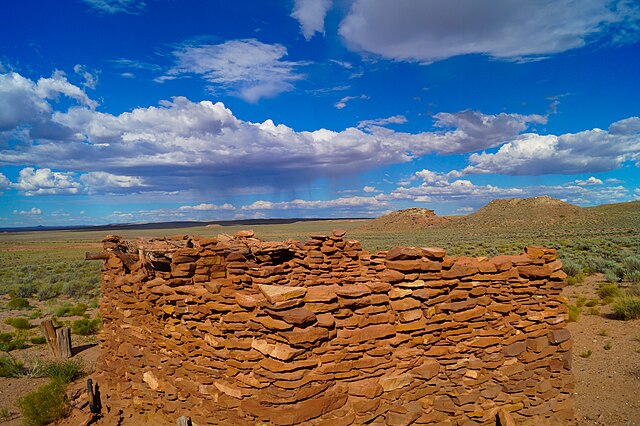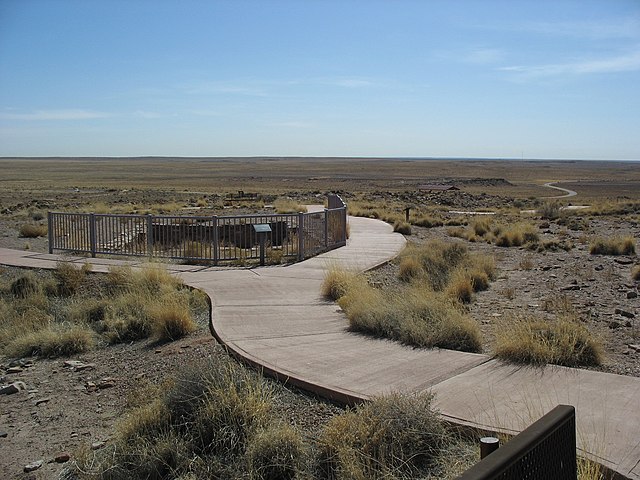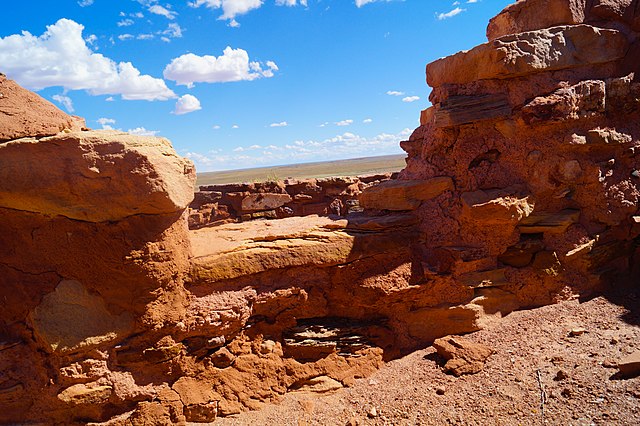Have you ever wondered what it would be like to walk through an ancient civilization’s backyard? Homolovi State Park in Arizona offers exactly that experience, serving as a remarkable window into the past where the ancestors of the Hopi people once thrived. This 4,000-acre archaeological wonderland sits just northeast of Winslow, Arizona, preserving not just ruins but an entire cultural legacy that spans over 700 years.
Unlike the crowded tourist destinations that dot Arizona’s landscape, Homolovi remains a hidden gem where you can explore ancient pueblo ruins, discover petroglyphs, and connect with Native American history in an intimate, unhurried setting. The park’s name itself tells a story – “Homolovi” means “place of the little hills” in the Hopi language, perfectly describing this gently rolling landscape dotted with archaeological treasures.
What Makes Homolovi State Park Special?
Ancient Hopi Heritage and Cultural Significance
The magic of Homolovi lies in its authentic connection to living culture. This isn’t just another collection of old stones – it’s a sacred place where the Hopi people’s ancestors lived, worked, and thrived from approximately 1260 to 1400 CE. The Hopi consider these ruins to be footprints of their ancestors, making Homolovi a living testament to their cultural heritage.
What sets this park apart is its collaborative management approach. The Arizona State Parks system works closely with the Hopi Tribe to ensure that the sites are preserved and interpreted with cultural sensitivity and accuracy. This partnership creates an educational experience that goes beyond typical archaeological tourism, offering visitors genuine insights into Hopi culture, traditions, and the deep spiritual connection between the people and the land.
The ruins at Homolovi represent more than just abandoned buildings – they’re evidence of a sophisticated society that successfully adapted to the challenging high desert environment. These ancestral Hopi communities developed innovative farming techniques, created intricate pottery, and built structures that have withstood centuries of weather and time.
Unique Archaeological Features
Homolovi State Park contains over 300 archaeological sites, ranging from small artifact scatters to large pueblo complexes. The most significant features include several major pueblo ruins, each with its own story to tell. These aren’t reconstructed tourist attractions but authentic archaeological sites where you can see original construction techniques, room layouts, and architectural details that reveal how these ancient communities lived.
The park’s archaeological significance extends beyond the buildings themselves. Pottery sherds, stone tools, and other artifacts scattered throughout the area provide clues about daily life, trade relationships, and cultural practices. The preservation of these sites in their original context allows researchers to continue learning about ancestral Hopi culture while providing visitors with an authentic educational experience.
Planning Your Visit to Homolovi State Park
Best Times to Visit
Timing your visit to Homolovi can make the difference between a good experience and an extraordinary one. The park operates year-round, but the desert climate means you’ll want to plan around both weather and lighting conditions for the best experience.
Spring (March through May) offers ideal conditions with mild temperatures, blooming desert plants, and comfortable hiking weather. This season provides perfect conditions for exploring the ruins and trails without the intense heat of summer. Fall (September through November) presents another excellent window with similar moderate temperatures and often spectacular sunsets that illuminate the ancient stones.
Summer visits require careful planning due to intense heat that can reach over 100°F. If you visit during summer months, plan your activities for early morning or late afternoon, and always carry plenty of water. Winter can be surprisingly cold with occasional snow, but clear winter days offer unique photographic opportunities and fewer crowds.
Park Hours and Admission Fees
Homolovi State Park maintains visitor-friendly hours that accommodate both early risers and those who prefer leisurely starts. The park typically opens at 8:00 AM and closes at 5:00 PM, with extended hours during peak seasons. The visitor center operates on a similar schedule, though it’s worth calling ahead to confirm current hours, especially during holidays or special events.
Admission fees are structured to encourage longer visits while remaining affordable for families. Arizona residents receive discounted rates, and annual passes are available for frequent visitors. The fees help support ongoing archaeological preservation efforts and educational programs, making your visit an investment in protecting these irreplaceable cultural resources.
Getting There: Directions and Transportation
Reaching Homolovi State Park is straightforward, with the park located just off State Route 87, about 1.3 miles northeast of Winslow, Arizona. The drive from Flagstaff takes approximately one hour, while Phoenix visitors can expect a two-hour journey through some of Arizona’s most scenic high desert landscape.
The park entrance road is well-maintained and suitable for all vehicle types, including RVs and trailers. Clear signage guides you from the highway to the visitor center, where you can pick up maps, pay admission fees, and gather information about current trail conditions and ranger programs.
Public transportation options are limited in this rural area, so having your own vehicle is essential. The nearest major airport is in Flagstaff, about 55 miles away, making Homolovi accessible for visitors flying into Arizona.
Top Attractions and Things to Do

Exploring the Ancient Pueblo Ruins
The heart of any Homolovi visit lies in exploring the ancient pueblo ruins that give the park its significance. These aren’t just piles of old stones – they’re carefully preserved archaeological sites where you can walk through actual rooms, see original construction techniques, and imagine daily life in a thriving ancient community.
Homolovi I: The Crown Jewel
Homolovi I stands as the park’s most impressive and accessible ruin complex. This massive pueblo once contained over 400 rooms and housed several hundred people at its peak. As you walk through the stabilized remains, you’ll notice the sophisticated construction techniques that allowed these buildings to survive for over 600 years.
The site features multiple room blocks, courtyards, and ceremonial areas that reveal the complex social organization of ancestral Hopi society. Interpretive signs help visitors understand the function of different areas while respecting the cultural sensitivity of the site. The views from Homolovi I across the Little Colorado River valley are spectacular, helping you understand why this location was chosen for such a significant settlement.
Homolovi II: The Residential Complex
Homolovi II offers a more intimate look at ancient daily life. This smaller but equally fascinating site provides insights into residential architecture and family life in the ancestral Hopi community. The ruins here are less extensive than Homolovi I but offer unique features including well-preserved room layouts and evidence of domestic activities.
Walking through Homolovi II, you can see grinding stones (metates) still in their original positions, fire hearths, and storage areas that bring ancient life into focus. The site’s position on a low hill provides excellent views of the surrounding landscape while demonstrating the strategic location choices made by ancient builders.
Petroglyphs and Rock Art Discovery
Beyond the pueblo ruins, Homolovi State Park contains numerous petroglyphs and rock art panels that add another dimension to your archaeological exploration. These ancient images, carved and painted on rock surfaces, provide insights into the spiritual and artistic life of the ancestral Hopi people.
The park’s petroglyph sites are scattered throughout the area, with some easily accessible from main trails while others require short hikes to reach. The images include geometric designs, animal figures, and abstract symbols that may have held religious or cultural significance. Some petroglyphs might represent clan symbols, astronomical observations, or spiritual concepts that connected the people to their environment.
Viewing these ancient artworks requires patience and careful observation, as the images blend into the natural rock surfaces. The best lighting for petroglyph viewing typically occurs in early morning or late afternoon when the angled sunlight creates shadows that make the carved images more visible.
Hiking Trails and Nature Walks
The trail system at Homolovi State Park is designed to provide access to archaeological sites while protecting sensitive areas from damage. The main trails are well-maintained and suitable for most fitness levels, though the high desert environment requires proper preparation and hydration.
The Homolovi I Trail offers the most comprehensive experience, leading visitors through the largest pueblo complex while providing interpretive information about ancient architecture and daily life. This relatively easy walk takes most visitors 30-45 minutes, allowing time to explore different areas of the ruins and read interpretive signs.
For those seeking a more challenging experience, the backcountry trails provide access to more remote archaeological sites and offer opportunities to see the park’s natural environment. These trails require more preparation and navigation skills but reward hikers with solitude and the chance to discover lesser-known petroglyphs and ruins.
Visitor Center and Educational Experiences
Interactive Exhibits and Displays
The Homolovi State Park visitor center serves as your gateway to understanding the cultural and historical significance of the sites you’ll explore. The center features professionally designed exhibits that bring ancient life into focus through artifacts, interactive displays, and multimedia presentations.
The centerpiece of the visitor center is a collection of pottery, stone tools, and other artifacts recovered from the park’s archaeological sites. These items provide tangible connections to the people who lived here centuries ago. Interactive displays allow you to examine pottery-making techniques, understand ancient farming methods, and learn about the seasonal cycles that governed daily life.
One of the most valuable aspects of the visitor center is its emphasis on contemporary Hopi culture. Rather than presenting the ruins as belonging to a “lost” civilization, the exhibits clearly connect the archaeological sites to modern Hopi communities, emphasizing the continuity of culture and the living legacy of the ancestral sites.
Ranger Programs and Guided Tours
The park’s ranger programs elevate your visit from simple sightseeing to genuine education. These programs are led by knowledgeable interpreters who combine archaeological expertise with cultural sensitivity to provide insights you couldn’t gain from self-guided exploration alone.
Scheduled programs vary by season but typically include guided walks through the major ruins, petroglyph tours, and evening programs that might cover topics like ancient astronomy, traditional crafts, or desert ecology. The guides bring the ruins to life by explaining construction techniques, discussing daily life in the ancient pueblos, and sharing stories that connect visitors to the human experience of the site.
Special programs are often scheduled during peak visitor seasons or in conjunction with cultural events. These might include traditional craft demonstrations, storytelling sessions, or collaborative programs with Hopi cultural representatives. Checking the park’s program schedule before your visit ensures you don’t miss these enhanced educational opportunities.
Camping and Accommodation Options
Campground Facilities and Amenities
Homolovi State Park offers a peaceful camping experience that allows you to extend your archaeological exploration over multiple days. The campground provides a perfect base for experiencing the park’s sites during different lighting conditions and seasons, particularly for photography enthusiasts who want to capture the ruins during golden hour or under starlit skies.
The campground features both RV sites with electrical hookups and tent camping areas, accommodating various camping preferences and equipment. Sites are spacious and well-maintained, with picnic tables and fire rings that make for comfortable outdoor dining and evening relaxation. The campground’s location provides easy access to the main ruins while offering views of the surrounding high desert landscape.
Modern restroom facilities with showers are available, making the camping experience comfortable for families and those new to outdoor recreation. The campground also features a dump station for RVs and potable water access. The relatively small size of the campground maintains a peaceful atmosphere while providing adequate facilities for visitors.
Nearby Lodging Alternatives
For visitors who prefer indoor accommodations, the nearby town of Winslow offers various lodging options within a short drive of the park. Winslow’s historic downtown area features several motels and hotels that cater to Route 66 travelers while providing convenient access to Homolovi State Park.
The town’s lodging options range from budget-friendly motels to more upscale accommodations, many with themes that celebrate Winslow’s place in American highway history. Some hotels offer packages that include park admission or dining vouchers for local restaurants, adding value to your archaeological adventure.
Flagstaff, about an hour’s drive away, provides additional accommodation options including chain hotels, bed and breakfasts, and vacation rentals. While the drive is longer, Flagstaff offers more dining and shopping options, making it a good base for visitors who want to explore multiple northern Arizona attractions.
Wildlife and Natural Environment

Desert Flora and Fauna
While archaeology draws most visitors to Homolovi State Park, the high desert environment provides fascinating insights into how ancient peoples adapted to and thrived in this challenging landscape. The park’s elevation of about 4,900 feet creates a unique ecosystem that supports diverse plant and animal communities.
The vegetation includes classic high desert species like four o’clock, snakeweed, and various grasses that the ancestral Hopi people used for food, medicine, and construction materials. Juniper and pinyon pine trees dot the landscape, providing the same resources that ancient communities relied on for fuel, construction, and food (pine nuts).
Wildlife observation opportunities abound for patient visitors. Common sightings include cottontail rabbits, ground squirrels, and various lizard species. Larger mammals like mule deer and elk occasionally visit the park, particularly during early morning or evening hours. The diversity of desert wildlife helps visitors understand the hunting and gathering resources that supported ancient communities.
Birdwatching Opportunities
The park’s location along the Little Colorado River valley creates excellent habitat for both resident and migratory bird species. Birdwatching at Homolovi offers the opportunity to see species that the ancestral Hopi people would have observed, hunted, and incorporated into their cultural practices.
Resident species include various hawk species, ravens, and smaller songbirds that thrive in the high desert environment. During migration seasons, the park becomes a stopping point for species traveling between breeding and wintering grounds. The combination of riparian areas near the river and upland desert habitats creates diverse niches for different bird species.
Early morning and late afternoon provide the best birdwatching opportunities, when cooler temperatures increase bird activity. The visitor center staff can provide current information about seasonal bird activity and suggest the best locations for observation within the park.
Photography Tips and Best Spots
Capturing the Ancient Ruins
Photographing the ruins at Homolovi State Park requires both technical skill and cultural sensitivity. The goal is to capture the beauty and significance of these ancient sites while respecting their cultural importance and following park regulations designed to protect archaeological resources.
The best lighting for ruin photography typically occurs during the golden hours shortly after sunrise and before sunset. During these times, the warm light illuminates the sandstone construction while creating dramatic shadows that emphasize architectural details. The contrast between the ancient stones and the expansive desert landscape becomes most apparent during these lighting conditions.
Composition considerations include using the natural landscape to frame the ruins, incorporating foreground elements like native plants or rock formations, and capturing the scale of the structures by including people (with permission) in your shots. Wide-angle lenses help capture the full scope of the pueblo complexes, while telephoto lenses can isolate architectural details and create intimate views of construction techniques.
Landscape and Sunset Photography
The high desert landscape surrounding Homolovi State Park provides spectacular opportunities for landscape photography that goes beyond the archaeological sites. The combination of rolling hills, distant mountains, and expansive skies creates compositions that capture the essence of the American Southwest.
Sunset photography from various viewpoints within the park can produce dramatic images that combine ancient ruins with natural beauty. The western horizon often features spectacular cloud formations that create colorful displays as the sun sets. The park’s relatively dark skies also provide opportunities for night photography, including star trails and Milky Way images that show the same celestial displays that ancient peoples observed.
Weather considerations play a crucial role in landscape photography at Homolovi. Summer monsoon storms can create dramatic skies with lightning and rainbow opportunities, while winter storms might produce snow-covered ruins and unique atmospheric conditions. Checking weather forecasts and being prepared for changing conditions can lead to exceptional photographic opportunities.
Safety Tips and Park Regulations
Weather Considerations
The high desert environment at Homolovi State Park presents unique challenges that require preparation and awareness. Temperature extremes, sudden weather changes, and the effects of high altitude can catch unprepared visitors off guard, potentially turning an enjoyable educational experience into a dangerous situation.
Summer temperatures can exceed 100°F during midday hours, making heat exhaustion and dehydration serious concerns. Always carry more water than you think you’ll need – at least one gallon per person per day during hot weather. Wear sun protection including hats, sunglasses, and long-sleeved shirts, and plan strenuous activities for early morning or late afternoon hours.
Winter weather can be surprisingly harsh, with temperatures dropping below freezing and occasional snow or ice making trails treacherous. Layered clothing, sturdy footwear with good traction, and emergency supplies become essential during cold weather visits. Always check current weather conditions and dress appropriately for changing conditions.
Protecting Archaeological Sites
Visiting Homolovi State Park comes with the responsibility to protect irreplaceable archaeological resources for future generations. The sites you’ll explore are fragile and non-renewable – damage to ruins, petroglyphs, or artifact sites represents permanent loss of cultural heritage.
Staying on designated trails protects both the archaeological sites and the natural environment while ensuring your own safety. Climbing on ruins, moving stones, or disturbing artifact scatters can cause irreparable damage to sites that have survived for centuries. The temptation to collect “souvenirs” must be resisted – all artifacts, pottery sherds, and even small stones are protected by federal and state laws.
Photography is generally permitted and encouraged, but avoid using flash photography near petroglyphs or fragile ruins, as repeated exposure to bright light can cause fading or deterioration. Some sensitive sites may have photography restrictions, so always check with rangers about current policies before beginning your visit.
Nearby Attractions and Day Trips

Petrified Forest National Park
Located just 30 minutes east of Homolovi State Park, Petrified Forest National Park offers a perfect complement to your archaeological adventure. This unique park preserves one of the world’s most spectacular displays of petrified wood while also containing significant archaeological sites and petroglyphs.
The combination of Homolovi and Petrified Forest creates a comprehensive exploration of northeastern Arizona’s cultural and natural history. While Homolovi focuses on ancestral Hopi culture, Petrified Forest presents a broader timeline of human presence in the region, with evidence of occupation spanning thousands of years.
The drive between the two parks takes you through beautiful high desert scenery and provides opportunities to see how different ancient cultures adapted to similar environments. Many visitors find that experiencing both parks in the same trip creates a deeper understanding of the region’s complex cultural history.
Winslow and Route 66
The historic town of Winslow, just minutes from Homolovi State Park, adds another dimension to your northeastern Arizona adventure. Made famous by the Eagles song “Take It Easy,” Winslow celebrates its Route 66 heritage while serving as a gateway to regional attractions.
Winslow’s downtown area features the famous “Take It Easy” corner with its bronze statue and mural, along with various shops, restaurants, and galleries that celebrate both Route 66 culture and regional history. The town’s historic architecture includes the restored La Posada Hotel, considered one of the Southwest’s most beautiful historic hotels.
The combination of ancient archaeology at Homolovi and mid-20th century Americana in Winslow creates an interesting juxtaposition that highlights the layered history of the American Southwest. Many visitors enjoy exploring both the ancient and more recent past during their stay in the area.
Conclusion
Homolovi State Park represents far more than just another archaeological site – it’s a bridge between ancient wisdom and modern understanding, a place where the footprints of ancestral Hopi people remain visible in stone and earth. Your visit to this remarkable preserve contributes to the ongoing effort to protect and interpret these irreplaceable cultural resources while supporting the collaborative relationship between Arizona State Parks and the Hopi Tribe.
The experience of walking through rooms where families lived 700 years ago, seeing petroglyphs that may have recorded important events or spiritual beliefs, and standing in landscapes that supported thriving communities creates connections that extend far beyond typical tourism. Whether you’re drawn by archaeology, photography, hiking, or simply the desire to experience something authentic and meaningful, Homolovi State Park delivers an experience that enriches understanding of both ancient and contemporary Native American culture.
As you plan your visit, remember that you’re not just seeing tourist attractions but entering sacred spaces that hold deep meaning for the Hopi people. Approach your exploration with respect, curiosity, and appreciation for the privilege of experiencing these remarkable remnants of ancient American civilization. The stories held within Homolovi’s ruins, petroglyphs, and landscapes continue to teach us about human adaptation, cultural continuity, and the enduring connection between people and place.
Frequently Asked Questions
Q1: How long should I plan for a visit to Homolovi State Park?
A typical visit to Homolovi State Park requires 3-4 hours to explore the main ruins, visit the visitor center, and walk the primary trails. However, camping overnight allows for deeper exploration, better photography opportunities, and participation in ranger programs. Photography enthusiasts and serious archaeology buffs often spend multiple days to fully appreciate the site’s significance.
Q2: Are the ruins at Homolovi State Park accessible for visitors with mobility challenges?
The main visitor center is fully accessible, and the trail to Homolovi I (the largest ruin complex) is relatively flat and suitable for most mobility levels. However, accessing some petroglyphs and more remote ruins requires walking on uneven terrain. Visitors with specific accessibility needs should contact the park directly to discuss accommodation options and current trail conditions.
Q3: Can I bring my dog to Homolovi State Park?
Dogs are welcome at Homolovi State Park but must be kept on leashes at all times and are not permitted in the visitor center or on trails leading to archaeological sites. This policy protects both the sensitive archaeological resources and local wildlife. The campground and general park areas are dog-friendly, making it possible to bring pets while still enjoying much of what the park offers.
Q4: What’s the difference between Homolovi State Park and other Arizona archaeological sites?
Homolovi State Park is unique in its collaborative management with the Hopi Tribe, ensuring cultural authenticity in interpretation and preservation. Unlike some archaeological sites that present ancient cultures as “lost,” Homolovi explicitly connects the ruins to living Hopi communities. The park also offers a more intimate experience than larger, more crowded sites, with opportunities for extended exploration and camping.
Q5: Are there any restrictions on photography at Homolovi State Park?
Photography for personal use is generally permitted throughout the park, including at the ruins and petroglyphs. However, commercial photography and drone use require special permits. Flash photography near petroglyphs is discouraged to prevent damage to the rock art. Some sensitive archaeological areas may have temporary photography restrictions, so always check with rangers about current policies before beginning your visit.

